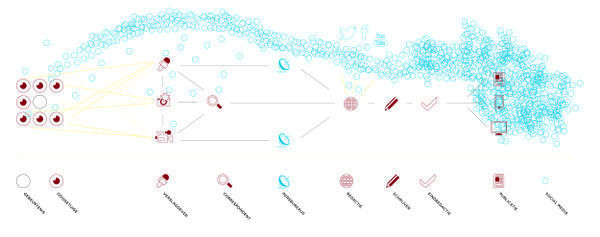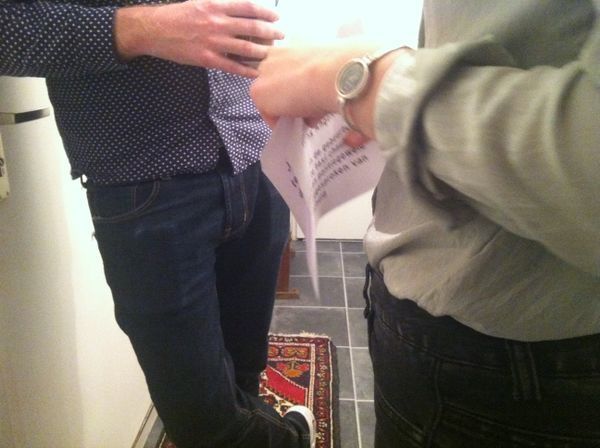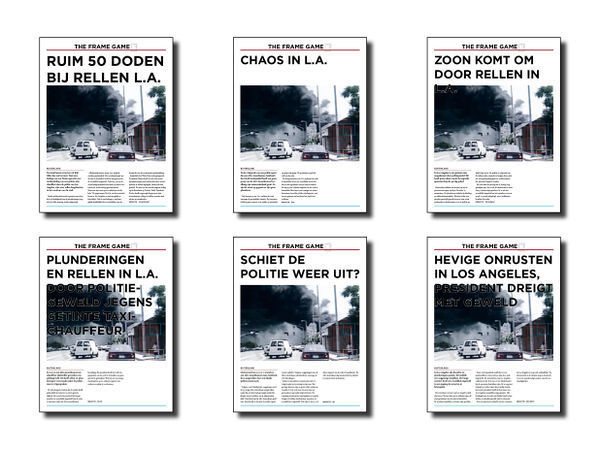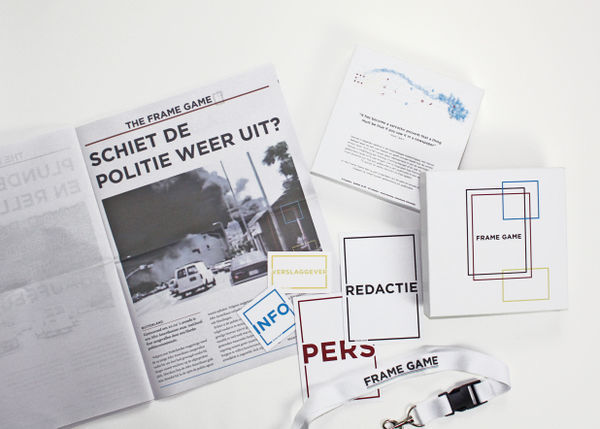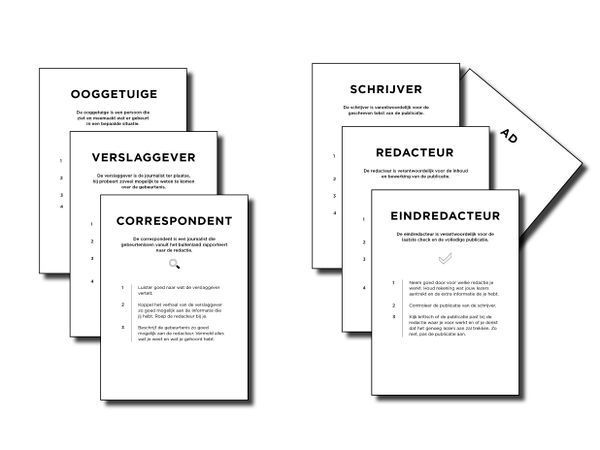The Frame Game
author: Lotte Biesheuvel
In order to raise awareness around framing in newsmedia, I designed a game that takes its players through all steps of making an newspaper article. The outcomes of the game will always be different, but for sure it makes its players realize framing goes far beyond what they might have guessed before playing.
Contents
Between the happening and publication
The news is omnipresent in our daily lives. We consume it from early morning till evening, in all kinds of ways, via TV, newspapers, internet, telephones and radio. It determines what we talk about and how we view the world. Still, most people are not aware of the fact that the news isn’t a representation of the truth. That’s nothing new, Mark Twain mentioned it already in 1873 “it has become a sarcastic proverb that a thing must be true if you saw it in a newspaper”. However it’s a current issue, because the news facilitates the viewing and discussion of current events. News is subject to framing, because of the many different steps between ‘the happening’ and the publication, the different people that are involved in every step and the goals everyone of these people pursue.
How framing takes shape
It often start with the eye witness, the closest to the incident, he experiences it from it’s own perspective. He’ll probably know some of the background of the happening but most of the time not all of it. He’ll respond very intuitive at the incident. The reporter which is a local journalist will research the incident, talk to eye witnesses and try to figure out the cause. He’s in contact with the correspondent. The correspondent usually isn’t anywhere close to the incident, he could even be working from a neighboring country. His job is to research the background of the incident and place it in a clarifying context. He reports to the editorial room of the news service he’s working for. The editorial room doesn’t only get information from the correspondent but also from different press agency’s and social media. The arrival of social media causes that an incident can be online long before it has reached the media, and can also be used in the final publication. Often the opinion of a social media user gets used as the public opinion. Which can lead to a new and different perspective in a publication. The editorial room has to make decisions concerning the publication by means of other news channels, public opinions and other events occurring that same day. They also have to take in account that they have to sell the story to their readers. The writer of the editorial room has to make sure the story is the right amount of words and consider the intentions of the editorial room. Also the headline should be catchy and attract a lot of readers. Briefly before the publication the editor in chief does a final review to check if their need to be small adjustments in the publication or it needs te be rewritten. Sometimes there isn’t enough space for the publication due to other important news and the publication needs to be shortened. A lot of information gets lost in this process due to framing. By understanding the process it gets clear how framing can happen. It happens conscious and unconscious. The eye witness, reporter and correspondent are unconsciously framing the incident, their mental representations simplifications and interpretations influence the way they cover the incident and how they communicate it. The editorial room, the writer and the editor in chief are consciously framing the incident by deliberately simplifying it and maneuvering it deliberately towards the wishes of the news consumer.
Why is it so important to be aware of framing?
The instant information and quickness of the subjects don't challenge to think about the complexness of the subjects of the news. Twitter, facebook and other opportunities to vent your opinion stimulate having an explicitit opinion. Framing is a form of priming, a form of unintentional influence. The human brain is a very associative network. For example, a person who sees the word "round" will be slightly faster to recognize the word "ball." This happens because round and ball are closely associated in memory. For instance when newsmedia talk about refugees, the words they use have a lot of negative connotations. And so these will be closely associated in memory. And this has a lot of influence on a persons judgemental skills. If the newsconsumer is aware of framing in newsmedia, he'll be more critical towards the significance of the news. And he'll might develop a more nuanced opinion about complex issues.
Making framing in newsmedia experiencable
In my graduation project at the WdKA I tried to create awareness around framing in news media. In previous research I developed an action scheme about how the process of awareness works. New perspectives and reflection are the two most important parts of this process. So I developed The Frame Game, a game where people are part of the press and discover how it works. It’s loosely based on a children's game, where the players whisper a sentence in each others ear and at the last player ends up with a complete different sentence then the start sentence. In The Frame Game the players each get a different role, from eye witness to editor in chief. The eye witness experiences an incident (a short video), and passes this on to reporter and so on till the editor in chief presents the publication. Each player has its own information and knows exactly what to do. In my research I played the game a lot of time with different groups of people but always with the same incident, first to constantly improve the game and later also to collect the publications each group wrote as result.
Interesting enough all the publications are very different in tone of voice, some of them are very accurate according the given information where others are very exaggerated. The game itself creates new perspectives and insights for the players, they experience how easy words can be twisted, how interpretations mislead and how editorial rooms have to make decisions. The reflection follows self evident because the group always consist of more than 5 players who will share their feelings on the game and will connect this to the real world. To stimulate this the game is played with the an incident that has a lot of connection with recent incidents. The game is played with a video and information of the Rodney King Riots, happened in 1993. Players don't recognize the video as part of the Rodney King Riots, but at the end of the game they make the connection between this game, the Riots in 1993 and recent events.
Next steps of the frame game
Currently I'm working on new incidents to play the game with so people can play it more than one time, and I'm also collecting the publications as result of playing the game. I'm looking for stakeholders to work with to get the game to a next level and to make it viable. To make the game even more actual I'm looking for ways to involve social media on a bigger scale. I'm also thinking of some other projects involving the future of news media. And the 'drempelprijs' is a good way to start.
Lotte Biesheuvel studied Graphic Design & Gamification at the WdKA, Rotterdam, With her graduation project 'the frame game' she has won the 'drempelprijs' within the social practices, an award for the best graduationproject of 2015.
